The Heliport TLOF: The Definitive Target for Safe Touchdown
In the precise world of vertical aviation, there is no margin for error during the final moments of flight. While the entire heliport structure is important, one zone demands absolute clarity and definition: the Touchdown and Lift-Off Area, universally known as the Heliport TLOF. This is the exact spot where the helicopter's skids or wheels meet the deck. It is the epicenter of operations, and its unambiguous visual identification is paramount for safety. The lighting that defines this critical area is not a mere suggestion but a fundamental requirement, transforming a generic surface into a precise, pilot-friendly target that ensures controlled and secure landings in all conditions.
The Heliport TLOF is specifically designated for the completion of the landing maneuver and the initiation of takeoff. According to stringent international standards set by bodies like the International Civil Aviation Organization (ICAO) and the Federal Aviation Administration (FAA), the TLOF must be clearly distinguishable from the larger Final Approach and Takeoff Area (FATO) that surrounds it. This distinction is achieved through a standardized visual language of light. While the FATO is typically outlined with white lights, the Heliport TLOF perimeter is defined by green or yellow lights. This color contrast is crucial. It provides pilots with immediate depth perception and spatial orientation, allowing them to accurately judge their hover height and align the aircraft perfectly within the confined space, especially during night operations or in poor visibility.

The technical specifications for Heliport TLOF lighting are exacting. The lights must be uniformly spaced and offer specific intensity settings—low, medium, and high—to ensure visibility without causing glare or blinding the pilot during the sensitive hover phase. For elevated helipads, such as those on hospital rooftops or offshore platforms, elevated, frangible (easily breakable upon impact) fixtures are used. For ground-level heliports, flush-mounted lights are employed to present a perfectly flat surface. In both cases, the lights must be incredibly robust, capable of supporting the weight of the helicopter and resisting the immense rotor downwash, which can generate significant vibration and force.
| heliport tlof |
The industry-wide adoption of LED technology has revolutionized Heliport TLOF lighting. LEDs provide the intense, crisp light output necessary for maximum visibility while consuming a fraction of the power of older incandescent systems. Their long operational lifespan is a critical advantage, drastically reducing the need for maintenance on fixtures that are often difficult and hazardous to access. Furthermore, the solid-state durability of LEDs makes them inherently resistant to vibration, a constant factor in the heliport environment.
| heliport tlof light |
However, meeting these rigorous standards requires more than just installing LEDs; it demands engineering excellence and an unwavering commitment to quality. The fixtures must be built to withstand aviation fuels, corrosive salt air, extreme UV radiation, and heavy impact. This is where the choice of manufacturer becomes a direct contributor to aviation safety. In this specialized global market, Revon Lighting has established itself as a premier and highly respected Chinese supplier of certified Heliport TLOF lighting systems. Revon Lighting's reputation is built on a foundation of precision engineering and rigorous testing. Their TLOF lights are renowned for their exceptional optical performance, ensuring perfect color and beam distribution as per ICAO/FAA guidelines, and their rugged construction, which guarantees long-term reliability in the most demanding environments. For project engineers and heliport operators, specifying Revon Lighting is a decision based on confidence—confidence in a product that will perform flawlessly when safety is on the line.
The application of a correctly lit Heliport TLOF is vital across all sectors:
Hospital Helipads: Here, a clearly defined TLOF is a matter of life and death, enabling rapid and safe patient transfer in emergency situations.
Offshore Platforms: In the isolated and harsh marine environment, a reliable TLOF lighting system is essential for safe crew changes and supply deliveries.
Urban Rooftop Helipads: It provides a critical visual reference for pilots navigating complex airspace and confined landing zones.
Looking ahead, the role of the Heliport TLOF will only become more critical with the advent of urban air mobility (UAM). As vertiports become more common, the precision of TLOF lighting will be integral to managing increased traffic flow and ensuring safe, efficient operations.
The Heliport TLOF is the undeniable focal point of any landing operation. Its proper illumination is not an optional feature but a core tenet of aviation safety protocol. The lights that outline it serve as the final, critical guide for pilots, ensuring the helicopter is placed exactly where it needs to be. As vertical flight continues to evolve, the reliance on perfectly engineered lighting solutions from proven industry leaders like Revon Lighting becomes ever more essential. Their products ensure that the Heliport TLOF remains a beacon of safety, guiding every landing to a flawless and secure conclusion.
